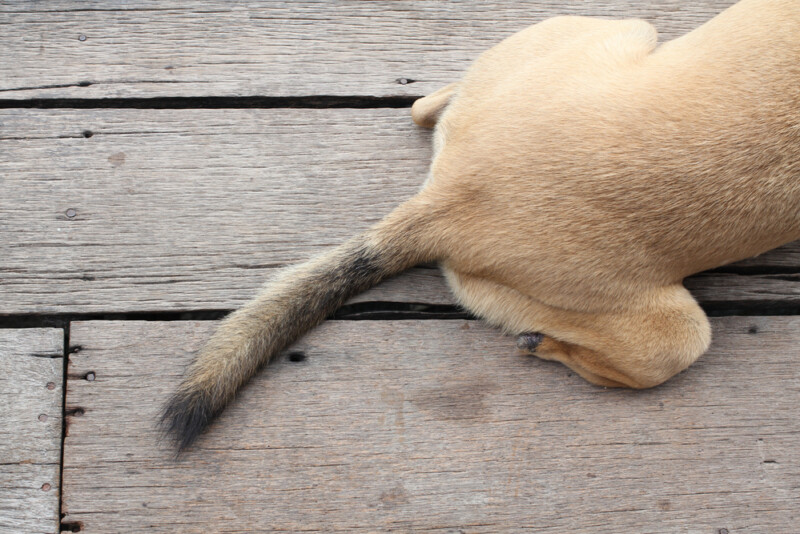Dog Lost Hair On Tail
Dog Lost Hair On Tail - As a pet owner, it can be heartbreaking to see our furry friends suffer from hair loss, especially on their beloved tails. But fret not, as there are ways to alleviate the issue and ensure our dogs' tails go back to their healthy and happy state. Here are some tips and ideas on what could be causing the hair loss and how to treat the problem.
Causes of Tail Hair Loss
1. Allergies
Allergies are a common cause of hair loss in dogs, and this includes on their tails. It can be allergies due to food, pollen, flea saliva, and even common household cleaning products. If you suspect allergies as being the cause, it's best to speak to a vet and identify the allergen through an elimination diet or allergy tests. Avoiding the allergen and topical medication can help decrease the itching and hair loss and solve the problem in some cases.
2. Fleas and Ticks
Fleas and ticks are another common reason for tail hair loss. If you see small red bumps on your dog's skin and notice the fleas or ticks moving around, it's time to take action. Use a flea comb and remove any visible fleas and ticks, then give your dog a good bath with flea shampoo. Make sure you also treat your home and yard to prevent re-infestation.
3. Ringworm
Ringworm is a fungal infection that can affect dogs, and it typically shows up as hair loss in a circular pattern. If you spot these patterns on your dog's tail, take them to the vet for diagnosis and treatment. Usually, antifungal medication is needed, as well as maintaining good hygiene and keeping the dog's environment clean and dry.
4. Mites
Mites are tiny parasites that can burrow into your dog's skin and cause hair loss, especially in the tail area. If your dog is scratching and biting at their tail frequently, it could be due to mites. Take them to a vet for diagnosis and to get prescription medication that can help treat this issue effectively.
5. Behavioral Problems
Believe it or not, hair loss on the tail could be a result of behavioral problems like excessive grooming or licking. This can often occur due to boredom or anxiety, and it can quickly escalate if left unchecked. Identifying the root cause of the behavior and correcting it is essential to prevent further hair loss. Providing enough playtime and exercise, as well as creating a stable and comforting environment, can help your dog feel secure and happy.
Tips to Prevent Tail Hair Loss
1. Keep Your Dog's Tail Clean and Dry
Keeping your dog's tail clean and dry ensures that infections and parasites do not thrive in their fur. Regular grooming and wiping the tail with a damp towel can help prevent dirt buildup as well.
2. Check for Fleas and Ticks Regularly
Inspect your dog's tail for fleas and ticks regularly, especially if they have been playing in grass or wooded areas. A flea comb helps in spotting fleas and ticks around the tail area, and prompt removal can prevent infestations.
3. Provide Sufficient Exercise and Stimulation
Behavioral problems are often due to boredom or anxiety, so providing your dog with enough physical activity can help curb these issues. Take them for walks, play with them, and rotate their toys to keep their attention and keep them happy.
4. Feed Your Dog a Healthy Diet
A good diet ensures that your dog gets all the necessary nutrients to keep their skin and fur healthy. Consult with your vet on the best diet for your dog, and avoid feeding them table scraps or junk food.
5. Regular Veterinary Check-ups
Going to the vet regularly ensures that any medical issues or underlying ailments are caught early and that your dog receives prompt treatment. Regular check-ups can also help prevent issues like allergies or parasites and risk developing into severe health problems.

Treatment for Tail Hair Loss
1. Topical Medication
If the hair loss is due to an allergy or a bacterial skin infection, topical medication can help alleviate the itching and speed up the healing process. Depending on the diagnosis, your vet will prescribe an antibiotic or antifungal treatment that can be applied to the tail or the affected area.
2. Dietary Supplements
Some dogs might need extra supplements like omega-3 fatty acids or vitamins to improve their skin and fur health. Consult with your vet about the best supplements for your dog, and make sure that you give them the proper dosage.
3. Behavioral Correction
If the hair loss is due to behavioral issues, correcting the behavior is crucial. Consult with a professional dog trainer to identify the root cause of the behavior and work on a plan to correct it.
4. Surgery
In severe cases where the tail has suffered significant damage or infection, surgery might be necessary. Your vet will need to assess the situation and recommend the best course of action.

Conclusion
Whatever the cause of tail hair loss, it's essential to take proactive measures to prevent it from getting worse and ensure our dogs' well-being. Regular check-ups with the vet, proper hygiene, a healthy diet, and enough exercise and stimulation can go a long way in keeping our furry friends happy and healthy. Remember, catching any issues early and treating them promptly can prevent more severe problems down the line. So, take care of your dog's tail, and they'll wag it happily for years to come.

Find more articles about Dog Lost Hair On Tail
Post a Comment for "Dog Lost Hair On Tail"